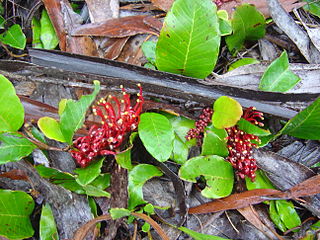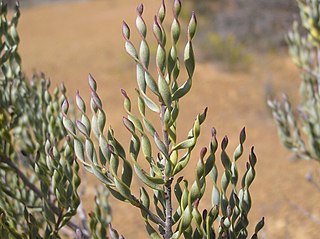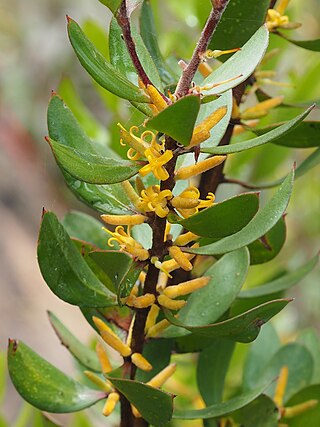
Persoonia, commonly known as geebungs or snottygobbles, is a genus of about one hundred species of flowering plants in the family Proteaceae. Plants in the genus Persoonia are shrubs or small trees usually with smooth bark, simple leaves and usually yellow flowers arranged along a raceme, each flower with a leaf or scale leaf at the base. The fruit is a drupe.

Grevillea laurifolia, commonly known as laurel-leaf grevillea, is a species of flowering plant in the family Proteaceae and is endemic to New South Wales. It is a prostrate, trailing shrub with egg-shaped, heart-shaped or round leaves, and clusters of reddish to deep maroon flowers.

Persoonia nutans, commonly known as the nodding geebung, is a plant in the family Proteaceae and is endemic to part of the Sydney region in New South Wales. It is an erect to spreading shrub with linear leaves and yellow flowers on down-turned pedicels.

Persoonia linearis, commonly known as the narrow-leaved geebung, is a shrub native to New South Wales and Victoria in eastern Australia. It reaches 3 m (9.8 ft), or occasionally 5 m (16 ft), in height and has thick, dark grey papery bark. The leaves are, as the species name suggests, more or less linear in shape, and are up to 9 cm (3.5 in) long, and 0.1 to 0.7 cm wide. The small yellow flowers appear in summer, autumn and early winter, followed by small green fleshy fruit known as drupes. Within the genus Persoonia, it is a member of the Lanceolata group of 58 closely related species. P. linearis interbreeds with several other species where they grow together.

Persoonia rigida, commonly known as the rigid-, hairy- or stiff geebung, is a species of flowering plant in the family Proteaceae and is endemic to south-eastern Australia. It is an erect to low-lying shrub with hairy young branchlets, lance-shaped to spatula-shaped leaves that are hairy when young, and yellow flowers borne in groups of up to twenty on a rachis up to 90 mm (3.5 in) long that continues to grow after flowering.

Persoonia pauciflora, commonly known as the North Rothbury persoonia, is a plant in the family Proteaceae and is endemic to a small area of New South Wales. It is a small, spreading shrub with bright green, thread-like leaves and a relatively small number of yellow flowers in summer. A recently described species, it is similar to P. isophylla but has fewer and shorter flowers than that species. A very restricted distribution has led to its classification as "critically endangered" under the Australian Government Environment Protection and Biodiversity Conservation Act 1999.

Persoonia myrtilloides, commonly known as myrtle geebung, is a plant in the family Proteaceae and is endemic to New South Wales. It is an erect to spreading shrub with elliptic to egg-shaped leaves and yellow flowers in groups of up to forty on a rachis up to 170 mm (6.7 in) long.

Persoonia glaucescens, commonly known as the Mittagong geebung, is a species of flowering plant in the family Proteaceae and is endemic to New South Wales. It is an erect shrub with smooth bark, hairy young branchlets, lance-shaped leaves with the narrower end towards the base, and yellow flowers. It is the only persoonia in eastern Australia with strongly glaucous leaves.

Persoonia hirsuta, commonly known as the hairy geebung or hairy persoonia, is a plant in the family Proteaceae and is endemic to eastern New South Wales. It is a hairy, spreading to low-lying shrub with linear, lance-shaped or spatula-shaped leaves and yellow or orange flowers arranged singly or in groups of up to ten on a rachis up to 20 mm (0.79 in) long.

Persoonia acerosa, commonly known as needle geebung, is a species of flowering plant in the family Proteaceae and is endemic to a restricted area of New South Wales. It is a shrub with small, channelled, needle-like leaves, yellow tubular flowers and yellowish-green, pear-shaped fruit.

Persoonia elliptica, commonly known as snottygobble or spreading snottygobble, is a plant in the family Proteaceae and is endemic to the south-west of Western Australia. It is an erect shrub or small tree with egg-shaped or lance-shaped leaves and groups of cylindrical yellow flowers. It usually grows in woodland or forest dominated by jarrah or marri within 50 km (30 mi) of the coast.

Persoonia helix is a species of flowering plant in the family Proteaceae and is endemic to the south-west of Western Australia. It is an erect to spreading shrub with hairy young branchlets, twisted leaves and bright yellow flowers borne singly or in groups of up to five on a rachis up to 25 mm (0.98 in) long.

Persoonia conjuncta is a species of flowering plant in the family Proteaceae and is endemic to eastern New South Wales. It is an erect shrub or small tree with narrow elliptic to lance-shaped leaves, yellow, tube-shaped flowers in groups of up to sixteen and green fruit.

Persoonia oleoides is a species of flowering plant in the family Proteaceae and is endemic to north-eastern New South Wales. It is an erect to low-lying shrub with oblong to egg-shaped leaves and yellow flowers in groups of up to twenty-five on a rachis up to 130 mm (5.1 in) long.

Persoonia cuspidifera is a species of flowering plant in the family Proteaceae and is endemic to northern New South Wales. It is an erect shrub with spatula-shaped leaves and greenish yellow, tube-shaped flowers in groups of up to twenty-five.

Persoonia microphylla is a plant in the family Proteaceae and is endemic to New South Wales. It is an erect to prostrate shrub with elliptic to egg-shaped leaves and yellow flowers in groups of up to fourteen on a rachis up to 30 mm (1.2 in) long.

Persoonia iogyna is a species of flowering plant in the family Proteaceae and is endemic to south-eastern Queensland. It is an erect shrub or small tree with hairy young branchlets, narrow elliptical to lance-shaped leaves, yellow flowers and green fruit.
Persoonia volcanica is a species of flowering plant in the family Proteaceae and is endemic to eastern Australia. It is an erect shrub with hairy young branchlets, egg-shaped to oblong leaves, and yellow flowers borne in groups of up to twenty on a rachis up to 180 mm (7.1 in) that usually continues to grow after flowering, each flower with a leaf at its base.
Persoonia cordifolia is a species of flowering plant in the family Proteaceae and is endemic to a restricted area in the south of Western Australia. It is an erect, rounded to spreading shrub with smooth, mottled grey bark, broadly heart-shaped leaves and bright yellow flowers borne in groups of two to eight along a rachis up to 25 mm (0.98 in) long.

Persoonia comata is a species of flowering plant in the family Proteaceae and is endemic to the south-west of Western Australia. It is an erect, sometimes spreading to low-lying shrub with mostly smooth bark, spatula-shaped to lance-shaped leaves with the narrower end towards the base and yellow flowers usually in groups of ten to fifty along a rachis up to 250 mm (9.8 in) long.




















